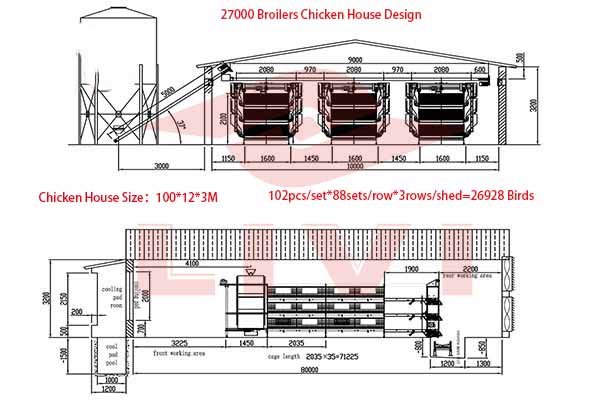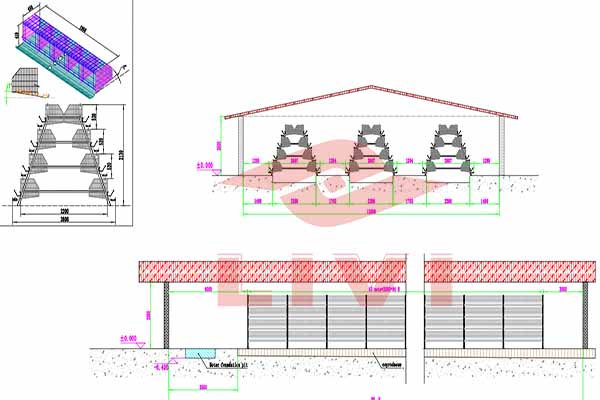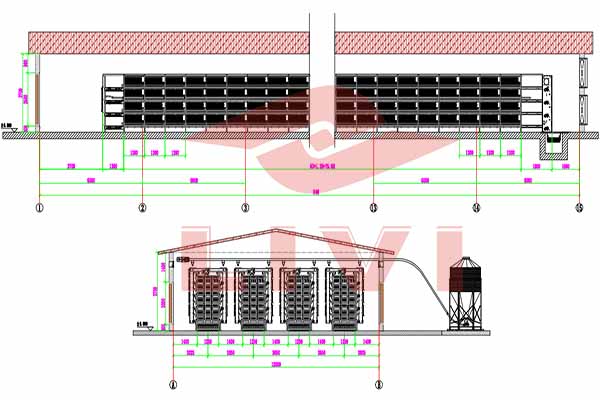4 Tips Of Raising Broiler Using Chicken Battery Cage
With the development of the scale of the breeding industry, the number of broiler cages is also increasing, but the ensuing problems are also one after another. For example, the temperature difference between the upper and lower cage, the height of the chicken house, how to cool down and ventilate in the hot summer. Livi Machinery has summarized the following 4 Tips Of Raising Broiler Using Chicken Battery Cage for you to help you improve the efficiency of chicken raising.
Advantages of Broilers chicken battery cage
Improved space utilization per unit.
Enhanced feed efficiency by 5% to 10%, reducing costs by 3% to 7%.
Savings on bedding costs.
Increased labor efficiency.
Facilitates gender separation for scientific management, boosting weight gain.
Effectively controls disease occurrence.
Pre-Rearing Cleaning and Disinfection Key Points
Cleaning of Chicken House and Cages:
Use tap water for thorough cleaning of the chicken house and cages, ensuring no dead corners. Clean feed troughs and water lines to avoid residue of feed, dirt, or feces.、
Disinfection of Chicken House and Cages:
For broiler cage system with high stocking density, disinfection is done via spraying or fumigation. Incomplete disinfection may lead to bacterial and viral residue, hampering future farming and disease prevention efforts. Rotate disinfectants and control dosage carefully. Before fumigation, close all doors and windows tightly, calculating the dosage based on the volume of the chicken house.
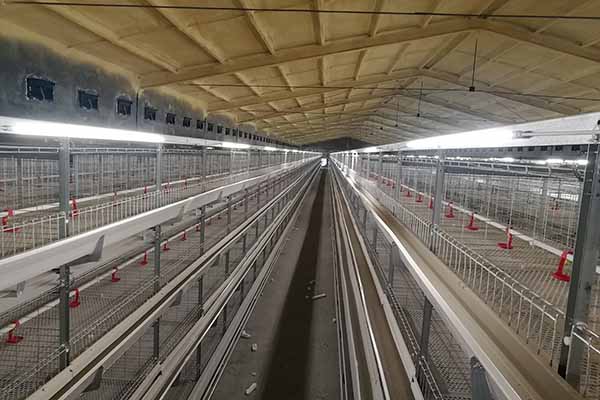
Key Management Points During the Broiler Rearing Period
Temperature Control in the Chicken House:
Control of Temperature Before Brooding: Raise the temperature inside the chicken house to 26°C before brooding. Ensure pre-warming to avoid cold spots.
Temperature Control During the Rearing Period: Maintain the temperature around 26°C from 21 days old until market weight, decreasing by 0.5°C per week.
Temperature Control During the Brooding: Adopt high-temperature brooding at 33°C, reducing by 0.5°C weekly thereafter. Monitor temperature closely to prevent fluctuations, which can reduce chick resistance.
Lighting Control in the Chicken House:
Lighting Control During the Brooding Period: Maintain a lighting intensity of 10-20 lux, preferably 10 lux, 24 hours a day. Install windows and skylights in the chicken house to regulate light intensity, ensuring uniformity and avoiding sudden changes.
Lighting Control During the Rearing Period: Reduce lighting to 5 lux, ensuring consistency between upper, middle, and lower tiers.
Ventilation Control in the Chicken House:
Ventilation Control During the Brooding Period:
Maintain a steady temperature without compromising ventilation. Use temperature controllers to regulate fans for proper air exchange.
Ventilation Control During the Rearing Period:
Adjust fan settings based on temperature variations, ensuring adequate oxygen levels without odor buildup.
Humidity Control in the Chicken House:
Control of Humidity in Brooding Period Chicken houses
The humidity in brooding period chicken houses should be maintained at 60-65%. Increasing the humidity in the house can be achieved by placing several containers of water inside, utilizing evaporation to increase the air humidity. Regular disinfection can also help increase humidity. It is not recommended to increase coop humidity by sprinkling water on the ground or installing sprinklers.
Control of Humidity in Growing Period Chicken houses
The humidity in growing period chicken houses should be maintained at 40-60%. Suitable humidity is conducive to the normal growth of broiler chickens. Humidity should not be too high or too low. If humidity is too low, it can lead to dehydration in chickens, poor feather growth, dry skin, airborne dust, and respiratory diseases. High humidity in summer can hinder chicken evaporation cooling, decrease feed intake, increase water consumption, and lead to heatstroke. In winter, high humidity can cause excessive heat loss in chickens, increase feed intake, and raise the feed-to-meat ratio, thereby increasing farming costs.
Feeding Control for Broiler Cage System:
Control of Feeding in Brooding Period for Broiler Chickens
During the brooding period, feeding principles for chicken battery cage broilers are consistent with those for floor-raised and free-range chickens. Artificial feeding is adopted using feeding trays rather than feeders. Feeding frequency during the brooding period is 6-8 times/day, ensuring frequent feeding to increase chicken feed intake.
Control of Feeding in Growing Period for Broiler Chickens
Feeding during the growing period for broiler chickens is carried out using feeding machines, typically twice daily, with adjustments in feeding frequency based on age. Combining machine feeding with manual feeding during the growing period helps prevent interruptions due to empty feeders, thus ensuring normal growth of broiler chickens.
Stocking Density Control for broiler cage system:
Control of Density in Chicken Coops During the Brooding Period
During the brooding period for chicken battery cage broilers, a combination of whole-house brooding and upper-level cage brooding is adopted, with a stocking density of 25 chickens per cage, eliminating overcrowding issues associated with whole-house brooding.
Control of Density in Chicken Coops During the Growing Period
The stocking density for poultry farming cage chickens during the growing period varies with the season, with lower densities in summer and slightly higher densities in winter, typically maintaining 8-9 chickens per cage.
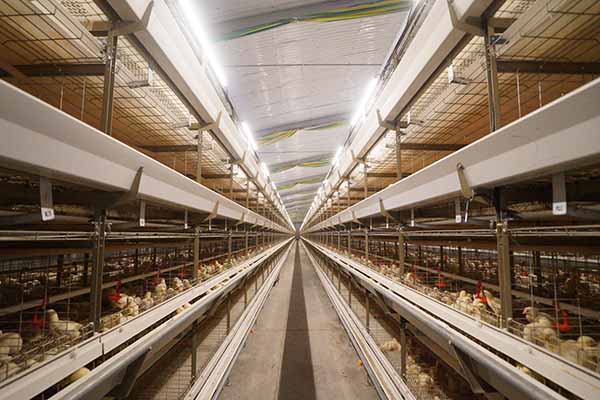
Issues to Note in Temperature Management for Cage-Raised Broiler Chickens
Temperature Considerations
(1) Proper Placement (Height and Quantity) of Thermometers
In standardized chicken coop management, where the length and width of the coop are relatively large, there may be temperature variations between the east-west or north-south sides. It is essential to place thermometers strategically. Placing one thermometer in the east, middle, and west sections of the coop allows for obtaining the average temperature inside the coop.
(2) Cooling Measures in Summer (Evaporative Cooling Pads)
During summer, temperatures inside the chicken house can be lowered using evaporative cooling pads. However, attention should be paid to the timing of operating the cooling pads to prevent the coop’s temperature from dropping too low or causing inconsistencies, which may lead to chickens catching colds.
(3) Temperature Control in Autumn
Autumn is characterized by significant temperature differences between day and night. Adjustments should be made to regulate the temperature inside the chicken house, avoiding sudden fluctuations in temperature.
(4) Insulation in Winter
During winter, measures such as heating or using blowers should be implemented to maintain adequate warmth inside the coop, ensuring that the temperature remains suitable for the broiler chickens’ well-being.
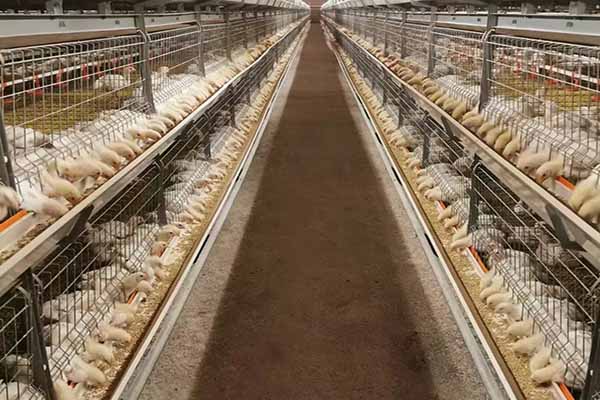
Issues to Note Regarding Stocking Density
In poultry farming cage chicken management, paying attention to density involves observing the different feed intake of chickens in each cage and adjusting the number of chickens in each cage to ensure uniform feed intake.
Issues to Note Regarding Immunization
In the immunization of poultry farming cage chickens, the method of water-based immunization is often employed. During immunization, attention should be given to the dosage of vaccines and the timing of water consumption. Water consumption time should not be too long, as prolonged consumption may lead to a decrease in the efficacy of vaccine immunization.
Livi Machinery, a professional poultry equipment supplier, offers broiler chicken farming cages and automated equipment that significantly enhance farming efficiency. With Livi’s innovative solutions, farmers can optimize operations, maximize productivity, and ensure the welfare of their flocks.
Drop us a comment for a free quote on broiler cages.


